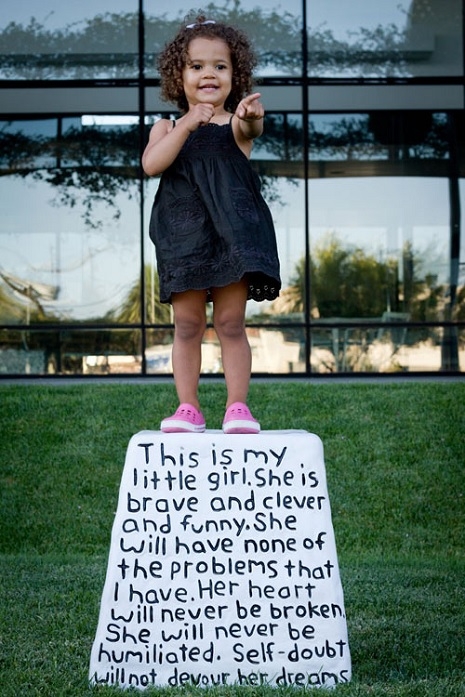
Little girl interacting with a piece from Miranda July’s outdoor exhibit, Eleven Heavy Things
Despite an early interest in both feminism and punk rock, Riot Grrrl never really appealed to me. I was in elementary school in the mid-90s—during the height of the Riot Grrrl zeitgeist—and while the aesthetic and mission statement certainly captured my snarling little heart, music was always my primary interest, and I just never found a Riot Grrrl band that really blew me away. My young ears suffered no dearth of chanteuses, of course. I just got my girl power from Joan Jett, Aretha Franklin, Dolly Parton, and those goddesses of mid-90s top 40 radio,TLC.
Still, I owe a debt to those women, and I can’t deny the legacy, especially when I come across great artifacts like this DIY documentary from a 1996 Riot Grrrl convention in Portland, Oregon. Organized by a smiling mohawked young woman named Geneva, the event was intended to foster a women’s community, make friends, and, she coyly admits, “I also needed a girlfriend.” (Let’s be honest, the prospect of romance has always been half the appeal of a good show.)
Though it boasts the production values of a decomposing home movie, the documentary is artfully edited, recording a wide array of performances, workshops, and interactions. It’s far more than a dredge of amateur bands, and the music line-up is surprisingly diverse—a two-girl group with an upright bass and a cello really stand out. The workshops were not only instructive, they encouraged women to create “out loud.” During a writing class, the teacher self-effacingly admits to a passion for the work of noted misogynist Charles Bukowski—there was clearly little to no pressure to maintain a “feminist cultural purity.” During a “basics” course on starting a band, a woman demonstrates all the instruments and identifies their parts. She even gives some sound advice on how not to get ripped off by music shops who might try and overcharge a woman. There’s poetry and avant garde performance and the introduction of the now legendary Free to Fight, the ambitious double LP concept album themed on violence against women. The record included a 75 page illustrated booklet with poetry, stories and advice—socialist feminist writer bell hooks even contributed.
I think the most impressive part of the event is how much fun everyone is having. Bands joke and banter onstage, making politically incorrect jokes about sexual orientation and gender. There’s self-defense demonstrations where nervous giggles from the audience grow into raucous laughter. The mood feels decidedly warm and easy-going throughout, with none of the humorless gravity one might associate with such serious subjects.
Those familiar with the Riot Grrrl scene might recognize a few of the musicians, but for me, the real Easter Egg is a very young Miranda July, doing a strange short performance piece, and using some of her own interview structure to contribute to the documentary. To be honest, not a lot of July’s work resonates with me—I think on some level I also avoid connecting with it, feeling foolish at the prospect of enjoying something so “dear.” For me, distorted guitars and screaming “fuck you” into a microphone has always been the accessible part of the Riot Grrrl arsenal.
But once in a while I see a Miranda July piece like the sculpture above and I’m floored by such honest vulnerability. And I remember there’s a less bombastic dimension to the Riot Grrrl legacy—something brave, but subtle. And I’m so grateful it happened.
And if that’s too dear for you, well… fuck you.